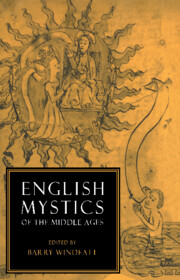Book contents
- Frontmatter
- Contents
- Acknowledgements
- Abbreviations
- Editorial note
- Introductory essay
- RICHARD ROLLE (c. 1300–1349)
- ANONYMOUS
- WALTER HILTON (d. 1396)
- 9 Epistle on the Mixed Life
- 10 Of Angels' Song
- 11 Eight Chapters on Perfection
- 12 The Scale of Perfection, Book I
- 13 The Scale of Perfection, Book II
- 14 Qui Habitat
- 15 The Prickynge of Love
- JULIAN OF NORWICH (1342– after 1416)
- MARGERY KEMPE (c. 1373– C. 1440)
- ANONYMOUS ENGLISH TRANSLATORS
- RICHARD METHLEY (1451/2–1527/8)
- Notes
- Guide to further reading
- Glossary
13 - The Scale of Perfection, Book II
Published online by Cambridge University Press: 06 July 2010
- Frontmatter
- Contents
- Acknowledgements
- Abbreviations
- Editorial note
- Introductory essay
- RICHARD ROLLE (c. 1300–1349)
- ANONYMOUS
- WALTER HILTON (d. 1396)
- 9 Epistle on the Mixed Life
- 10 Of Angels' Song
- 11 Eight Chapters on Perfection
- 12 The Scale of Perfection, Book I
- 13 The Scale of Perfection, Book II
- 14 Qui Habitat
- 15 The Prickynge of Love
- JULIAN OF NORWICH (1342– after 1416)
- MARGERY KEMPE (c. 1373– C. 1440)
- ANONYMOUS ENGLISH TRANSLATORS
- RICHARD METHLEY (1451/2–1527/8)
- Notes
- Guide to further reading
- Glossary
Summary
(Chapters 21, 33, 40, 41)
Book II of The Scale opens as if responding to a request from the anchoress-recipient of Book I to hear more about the soul as the image of God (1, 52), and deals with expulsion from the heart of the image of sin and re-formation of the soul in the image of Christ. But this later work conceives differently of its audience, representing a shifted, deepened understanding of what constitutes contemplation, and of those who may aspire to it. Unlike the earlier work (1, 15), Book II assumes its reader may follow the Latin scriptures (cf. 11, 43), and may not necessarily be enclosed. Hilton now sees contemplation as something which all rational souls created in the image of God should desire and dispose themselves to receive, whatever their state in life. With a calm assurance in utterance and in organization, Book II sets out a pondered formulation of Hilton's doctrine of contemplation in relation to theology, particularly in its concept of the progression from ‘reforming in faith’ to ‘reforming in feeling’. These terms are apparently Hilton's own, and reforming in feeling represents the practice of contemplation, dependent on infused grace. The earlier part of Book II treats reforming in faith: baptism and penance are the means of a first reforming of the soul, which is still apt to sin. With reforming of feeling, the influence of sinful impulses is past: the soul has what Hilton terms ‘a lifely feling of grace’, and the sublime sequence of concluding chapters (11, 33-45) are the culmination of Hilton's teaching on the nature of contemplation, suffused with a spiritual insight that would seem the distillation of great experience.
- Type
- Chapter
- Information
- English Mystics of the Middle Ages , pp. 156 - 172Publisher: Cambridge University PressPrint publication year: 1994



